stop start FIAT ULYSSE 2008 2.G User Guide
[x] Cancel search | Manufacturer: FIAT, Model Year: 2008, Model line: ULYSSE, Model: FIAT ULYSSE 2008 2.GPages: 254, PDF Size: 3.46 MB
Page 129 of 254

GETTING TO KNOW YOUR CAR
128
All control, repair and replacement
operations concerning the air bags
must only be carried out c/o Fiat
Dealership.
If the car is to be demolished, Fiat
Dealershipshould be contacted to
have the system deactivated.
If the vehicle changes ownership, the
new owner must be informed of the
method of use of air bags and the
above warnings and also be given this
“Owner handbook”.
IMPORTANTThe triggering of
pretensioners, front air bags and side
air bags is decided in a differentiated
manner by the electronic control unit,
depending on the type of crash. The
failure to deploy one or more of them
does not mean that the system is not
working properly.GENERAL NOTES
If the
¬warning light
does not turn on when
turning the ignition key to
M or if it stays on when travelling,
this could indicate a failure in
safety retaining systems; under
this condition air bags or preten-
sioners could not trigger in the
event of collision or, in a re-
stricted number of cases, they
could trigger accidentally. Stop
the car and contact Fiat Dealer-
ship to have the system checked
immediately.
When the ignition key is
turned to M, the warning
light
“(with the passen-
ger’s front air bag deactivation
switch in the ON position) turns
on for about 4 seconds and flash-
es for another 4 seconds to remind
that the passenger’s air bag and
side air bags will be deployed in a
crash, after which it should go off.
IMPORTANTTriggering of the air
bags releases a small amount of pow-
der. This powder is not harmful and
does not indicate the start of fire; al-
so the surface of the deployed bag and
the vehicle interior may be covered by
dusty residue: this may irritate the skin
and eyes. In the event of exposure,
wash with neutral soap and water.
The airbag system has a validity of 14
years for the pyrotechnic charge and
10 years for the coil contact . As this
date approaches, contact a Fiat Deal-
ership.
WARNINGSShould an accident
occur in which the Airbag is activated,
take the vehicle to a Fiat Dealership
to have the safety device, the elec-
tronic control unit, the seat belt, the
pretensioners and the electric system
checked.
Page 139 of 254
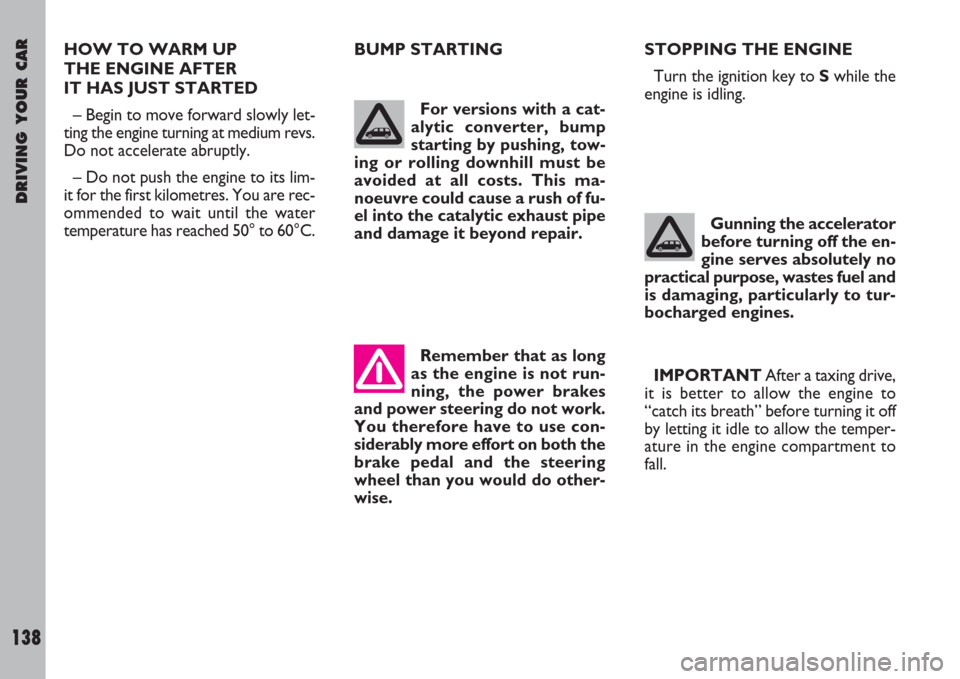
DRIVING YOUR CAR
138
HOW TO WARM UP
THE ENGINE AFTER
IT HAS JUST STARTED
– Begin to move forward slowly let-
ting the engine turning at medium revs.
Do not accelerate abruptly.
– Do not push the engine to its lim-
it for the first kilometres. You are rec-
ommended to wait until the water
temperature has reached 50° to 60°C.BUMP STARTING
For versions with a cat-
alytic converter, bump
starting by pushing, tow-
ing or rolling downhill must be
avoided at all costs. This ma-
noeuvre could cause a rush of fu-
el into the catalytic exhaust pipe
and damage it beyond repair.STOPPING THE ENGINE
Turn the ignition key to Swhile the
engine is idling.
Remember that as long
as the engine is not run-
ning, the power brakes
and power steering do not work.
You therefore have to use con-
siderably more effort on both the
brake pedal and the steering
wheel than you would do other-
wise.
Gunning the accelerator
before turning off the en-
gine serves absolutely no
practical purpose, wastes fuel and
is damaging, particularly to tur-
bocharged engines.
IMPORTANTAfter a taxing drive,
it is better to allow the engine to
“catch its breath” before turning it off
by letting it idle to allow the temper-
ature in the engine compartment to
fall.
Page 143 of 254
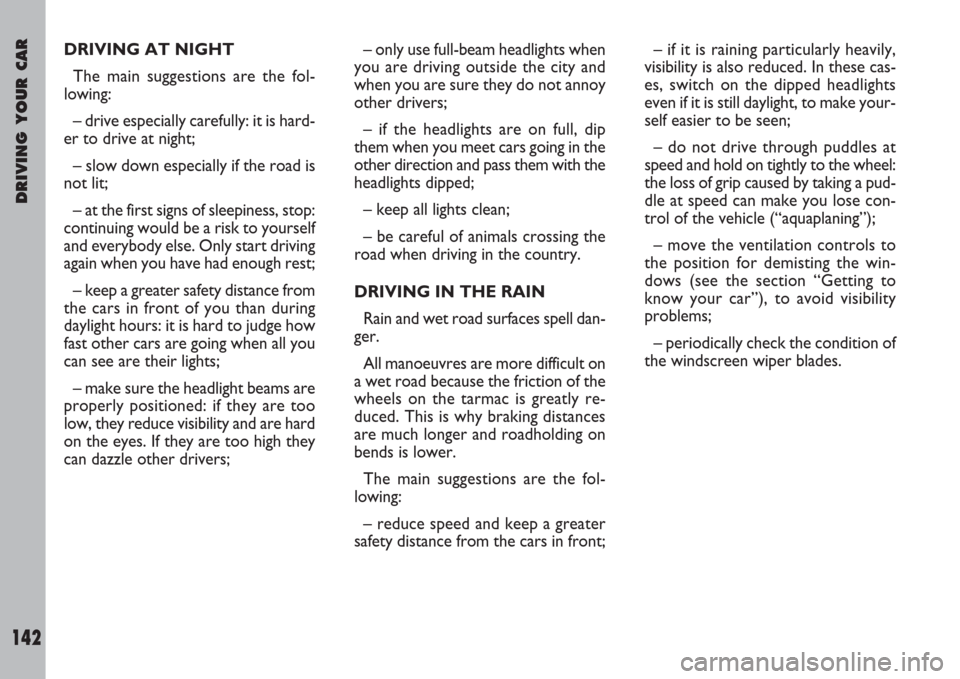
DRIVING YOUR CAR
142
– only use full-beam headlights when
you are driving outside the city and
when you are sure they do not annoy
other drivers;
– if the headlights are on full, dip
them when you meet cars going in the
other direction and pass them with the
headlights dipped;
– keep all lights clean;
– be careful of animals crossing the
road when driving in the country.
DRIVING IN THE RAIN
Rain and wet road surfaces spell dan-
ger.
All manoeuvres are more difficult on
a wet road because the friction of the
wheels on the tarmac is greatly re-
duced. This is why braking distances
are much longer and roadholding on
bends is lower.
The main suggestions are the fol-
lowing:
– reduce speed and keep a greater
safety distance from the cars in front;– if it is raining particularly heavily,
visibility is also reduced. In these cas-
es, switch on the dipped headlights
even if it is still daylight, to make your-
self easier to be seen;
– do not drive through puddles at
speed and hold on tightly to the wheel:
the loss of grip caused by taking a pud-
dle at speed can make you lose con-
trol of the vehicle (“aquaplaning”);
– move the ventilation controls to
the position for demisting the win-
dows (see the section “Getting to
know your car”), to avoid visibility
problems;
– periodically check the condition of
the windscreen wiper blades. DRIVING AT NIGHT
The main suggestions are the fol-
lowing:
– drive especially carefully: it is hard-
er to drive at night;
– slow down especially if the road is
not lit;
– at the first signs of sleepiness, stop:
continuing would be a risk to yourself
and everybody else. Only start driving
again when you have had enough rest;
– keep a greater safety distance from
the cars in front of you than during
daylight hours: it is hard to judge how
fast other cars are going when all you
can see are their lights;
– make sure the headlight beams are
properly positioned: if they are too
low, they reduce visibility and are hard
on the eyes. If they are too high they
can dazzle other drivers;
Page 144 of 254
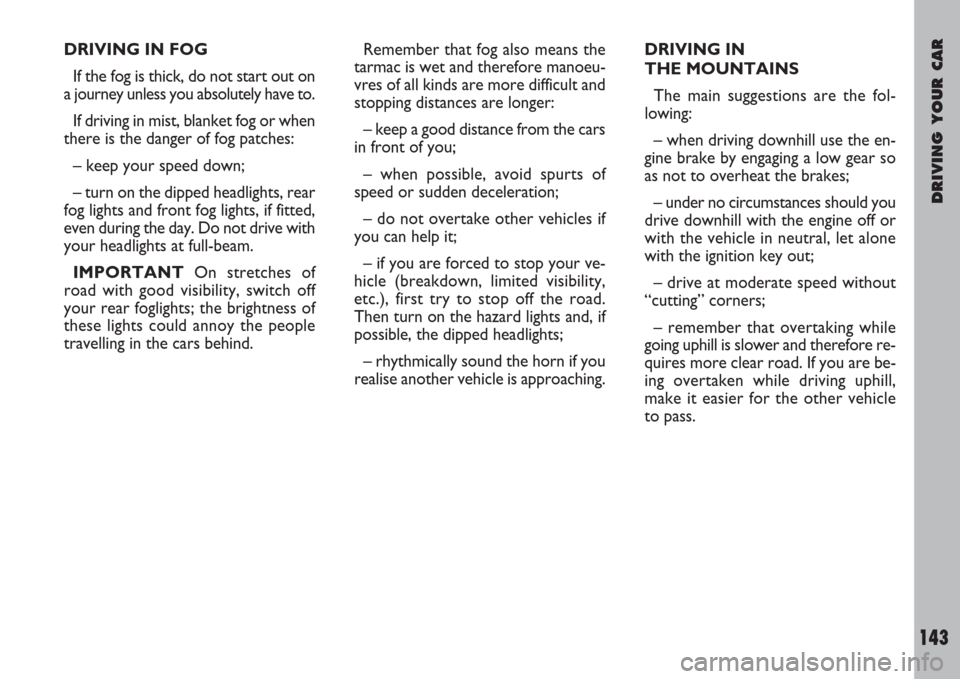
DRIVING YOUR CAR
143
Remember that fog also means the
tarmac is wet and therefore manoeu-
vres of all kinds are more difficult and
stopping distances are longer:
– keep a good distance from the cars
in front of you;
– when possible, avoid spurts of
speed or sudden deceleration;
– do not overtake other vehicles if
you can help it;
– if you are forced to stop your ve-
hicle (breakdown, limited visibility,
etc.), first try to stop off the road.
Then turn on the hazard lights and, if
possible, the dipped headlights;
– rhythmically sound the horn if you
realise another vehicle is approaching.DRIVING IN
THE MOUNTAINS
The main suggestions are the fol-
lowing:
– when driving downhill use the en-
gine brake by engaging a low gear so
as not to overheat the brakes;
– under no circumstances should you
drive downhill with the engine off or
with the vehicle in neutral, let alone
with the ignition key out;
– drive at moderate speed without
“cutting” corners;
– remember that overtaking while
going uphill is slower and therefore re-
quires more clear road. If you are be-
ing overtaken while driving uphill,
make it easier for the other vehicle
to pass. DRIVING IN FOG
If the fog is thick, do not start out on
a journey unless you absolutely have to.
If driving in mist, blanket fog or when
there is the danger of fog patches:
– keep your speed down;
– turn on the dipped headlights, rear
fog lights and front fog lights, if fitted,
even during the day. Do not drive with
your headlights at full-beam.
IMPORTANTOn stretches of
road with good visibility, switch off
your rear foglights; the brightness of
these lights could annoy the people
travelling in the cars behind.
Page 147 of 254
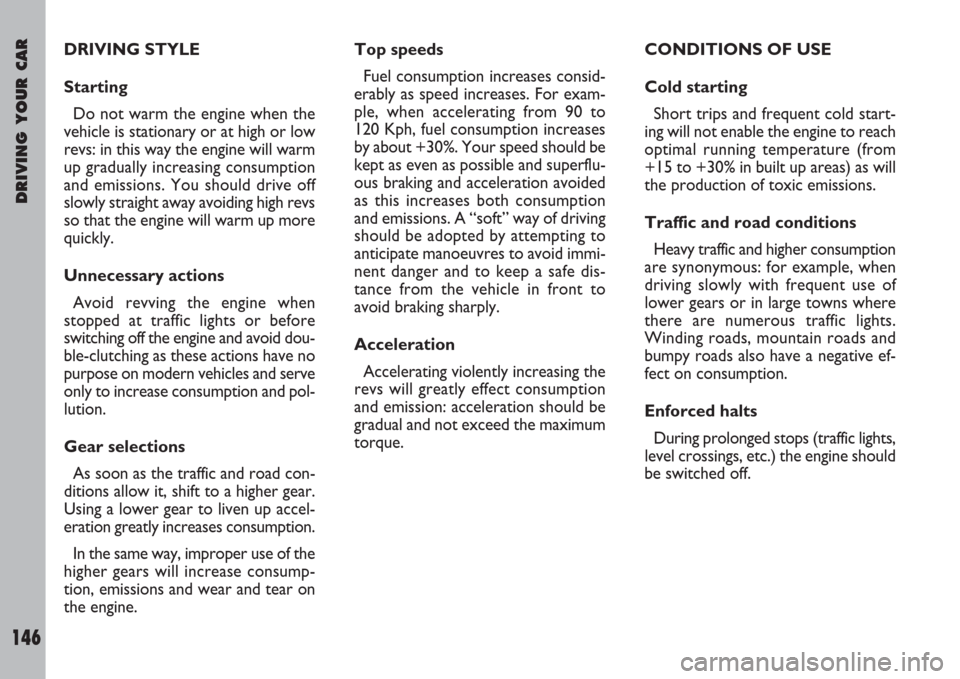
DRIVING YOUR CAR
146
DRIVING STYLE
Starting
Do not warm the engine when the
vehicle is stationary or at high or low
revs: in this way the engine will warm
up gradually increasing consumption
and emissions. You should drive off
slowly straight away avoiding high revs
so that the engine will warm up more
quickly.
Unnecessary actions
Avoid revving the engine when
stopped at traffic lights or before
switching off the engine and avoid dou-
ble-clutching as these actions have no
purpose on modern vehicles and serve
only to increase consumption and pol-
lution.
Gear selections
As soon as the traffic and road con-
ditions allow it, shift to a higher gear.
Using a lower gear to liven up accel-
eration greatly increases consumption.
In the same way, improper use of the
higher gears will increase consump-
tion, emissions and wear and tear on
the engine.Top speeds
Fuel consumption increases consid-
erably as speed increases. For exam-
ple, when accelerating from 90 to
120 Kph, fuel consumption increases
by about +30%. Your speed should be
kept as even as possible and superflu-
ous braking and acceleration avoided
as this increases both consumption
and emissions. A “soft” way of driving
should be adopted by attempting to
anticipate manoeuvres to avoid immi-
nent danger and to keep a safe dis-
tance from the vehicle in front to
avoid braking sharply.
Acceleration
Accelerating violently increasing the
revs will greatly effect consumption
and emission: acceleration should be
gradual and not exceed the maximum
torque.CONDITIONS OF USE
Cold starting
Short trips and frequent cold start-
ing will not enable the engine to reach
optimal running temperature (from
+15 to +30% in built up areas) as will
the production of toxic emissions.
Traffic and road conditions
Heavy traffic and higher consumption
are synonymous: for example, when
driving slowly with frequent use of
lower gears or in large towns where
there are numerous traffic lights.
Winding roads, mountain roads and
bumpy roads also have a negative ef-
fect on consumption.
Enforced halts
During prolonged stops (traffic lights,
level crossings, etc.) the engine should
be switched off.
Page 155 of 254

IN AN EMERGENCY
154
Do not carry out this
procedure if you lack ex-
perience; if it is not done
correctly it can cause very in-
tense electrical discharges. In ad-
dition, the fluid contained in the
battery is poisonous and corro-
sive. Avoid contact with skin and
eyes. You are also advised not to
put naked flames or lighted cig-
arettes near the battery and not
to cause sparks.
Remember that until
the engine has started the
brake booster and elec-
trical power steering systems will
not work and a greater effort will
therefore be required to press
the brake pedal or turn the steer-
ing wheel.IF A TYRE
IS PUNCTURED
Certain versions (where provided)
are fitted with wheel identification and
tyre inflation sensors; pressure loss is
signalled to the driver in the follow-
ing way:
pressure loss- the infotelematic
CONNECT system displays the relat-
ed message and a “gong” is emitted by
the system. Contact a Fiat Dealer-
ship;
punctured tyre- warning light
“STOP” comes on and the in-
fotelematic CONNECT system dis-
plays the related message together
with 3 consecutive “gong” sounds.
Change the wheel in the following
way.
The system can also display a dedi-
cated message in the event it should
not be able to detect the tyre pres-
sure. Under no circumstances
should a battery charger
be used to start the en-
gine: it could damage the elec-
tronic systems and in particular
the ignition and injection control
units.
BUMP STARTING
Do not bump start by
pushing, towing or coast-
ing downhill. This way of
starting could cause a rush of fu-
el into the catalytic converter and
damage it beyond repair.
Page 156 of 254
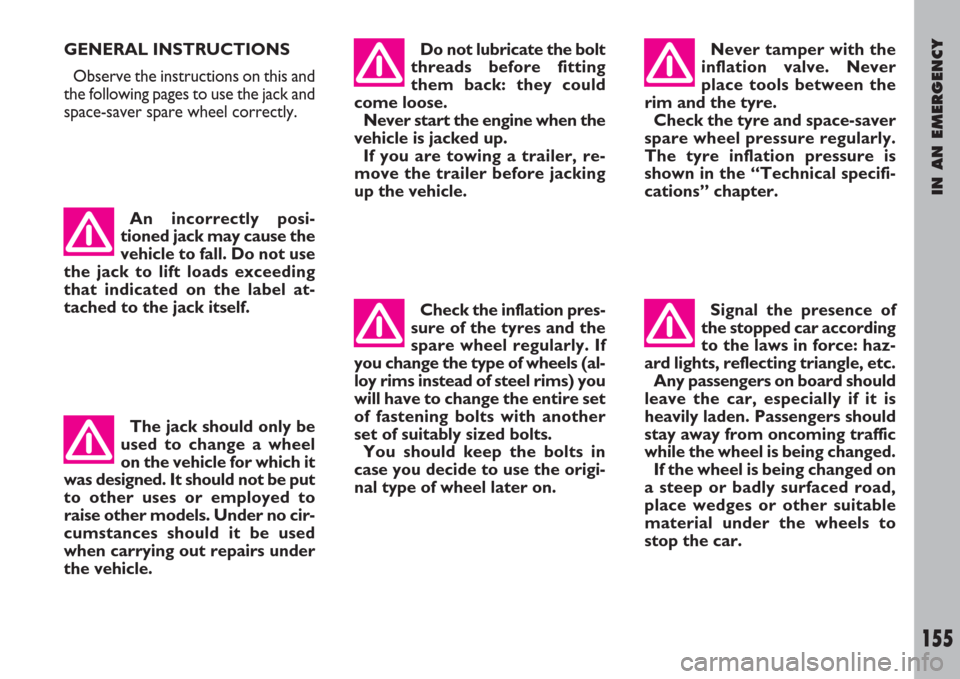
IN AN EMERGENCY
155
An incorrectly posi-
tioned jack may cause the
vehicle to fall. Do not use
the jack to lift loads exceeding
that indicated on the label at-
tached to the jack itself.Do not lubricate the bolt
threads before fitting
them back: they could
come loose.
Never start the engine when the
vehicle is jacked up.
If you are towing a trailer, re-
move the trailer before jacking
up the vehicle.Never tamper with the
inflation valve. Never
place tools between the
rim and the tyre.
Check the tyre and space-saver
spare wheel pressure regularly.
The tyre inflation pressure is
shown in the “Technical specifi-
cations” chapter.
The jack should only be
used to change a wheel
on the vehicle for which it
was designed. It should not be put
to other uses or employed to
raise other models. Under no cir-
cumstances should it be used
when carrying out repairs under
the vehicle.
Check the inflation pres-
sure of the tyres and the
spare wheel regularly. If
you change the type of wheels (al-
loy rims instead of steel rims) you
will have to change the entire set
of fastening bolts with another
set of suitably sized bolts.
You should keep the bolts in
case you decide to use the origi-
nal type of wheel later on.Signal the presence of
the stopped car according
to the laws in force: haz-
ard lights, reflecting triangle, etc.
Any passengers on board should
leave the car, especially if it is
heavily laden. Passengers should
stay away from oncoming traffic
while the wheel is being changed.
If the wheel is being changed on
a steep or badly surfaced road,
place wedges or other suitable
material under the wheels to
stop the car.
GENERAL INSTRUCTIONS
Observe the instructions on this and
the following pages to use the jack and
space-saver spare wheel correctly.
Page 193 of 254
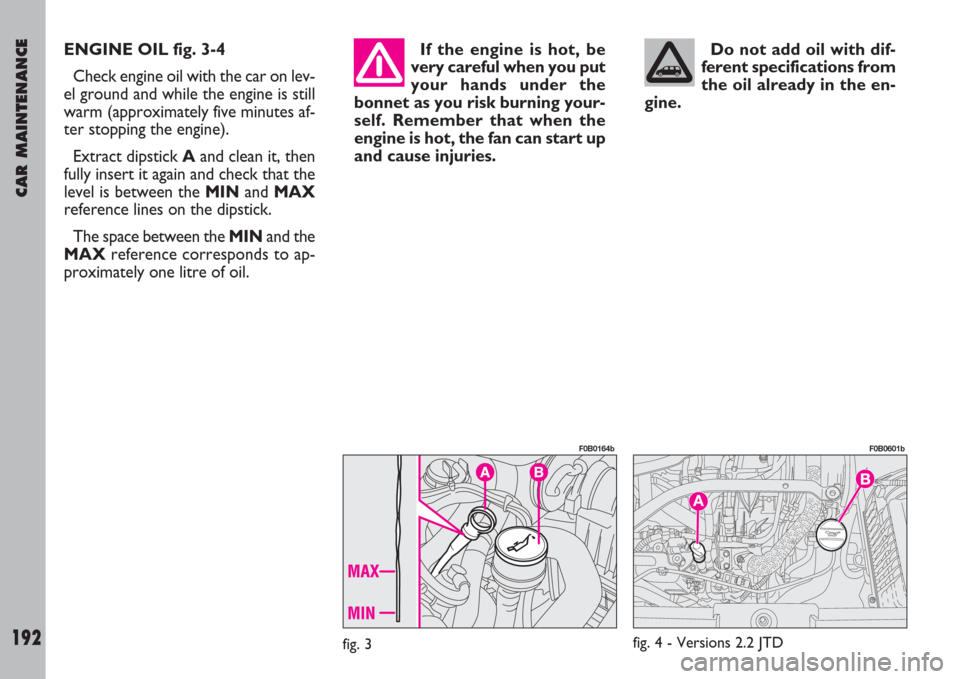
CAR MAINTENANCE
192
ENGINE OIL fig. 3-4
Check engine oil with the car on lev-
el ground and while the engine is still
warm (approximately five minutes af-
ter stopping the engine).
Extract dipstick Aand clean it, then
fully insert it again and check that the
level is between the MINand MAX
reference lines on the dipstick.
The space between the MINand the
MAXreference corresponds to ap-
proximately one litre of oil.Do not add oil with dif-
ferent specifications from
the oil already in the en-
gine.If the engine is hot, be
very careful when you put
your hands under the
bonnet as you risk burning your-
self. Remember that when the
engine is hot, the fan can start up
and cause injuries.
fig. 3
F0B0164b
fig. 4 - Versions 2.2 JTD
F0B0601b
Page 207 of 254
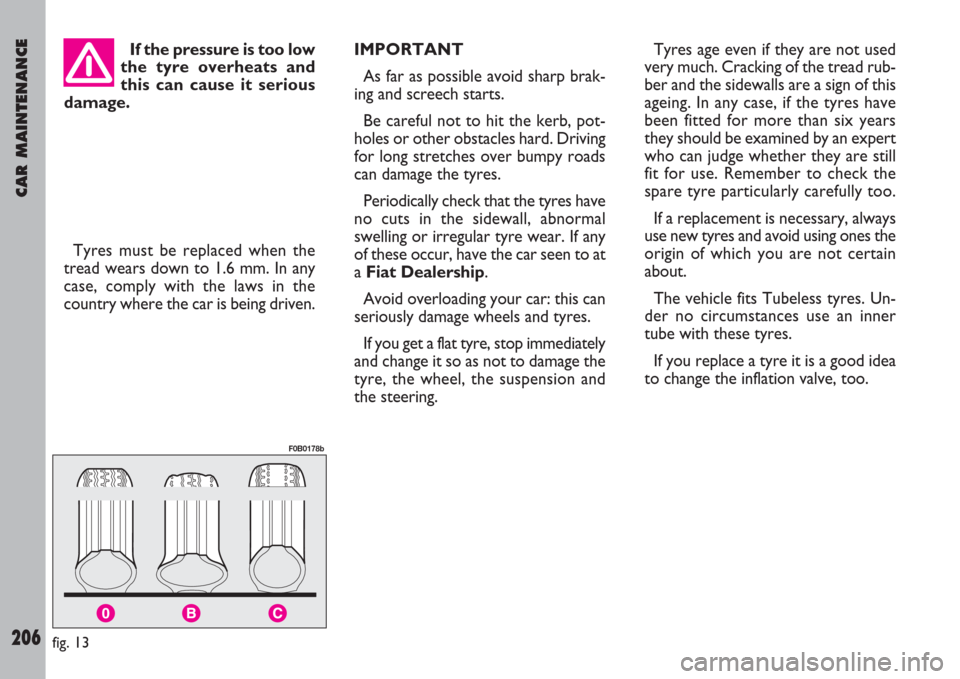
CAR MAINTENANCE
206
If the pressure is too low
the tyre overheats and
this can cause it serious
damage.
Tyres must be replaced when the
tread wears down to 1.6 mm. In any
case, comply with the laws in the
country where the car is being driven.IMPORTANT
As far as possible avoid sharp brak-
ing and screech starts.
Be careful not to hit the kerb, pot-
holes or other obstacles hard. Driving
for long stretches over bumpy roads
can damage the tyres.
Periodically check that the tyres have
no cuts in the sidewall, abnormal
swelling or irregular tyre wear. If any
of these occur, have the car seen to at
a Fiat Dealership.
Avoid overloading your car: this can
seriously damage wheels and tyres.
If you get a flat tyre, stop immediately
and change it so as not to damage the
tyre, the wheel, the suspension and
the steering.Tyres age even if they are not used
very much. Cracking of the tread rub-
ber and the sidewalls are a sign of this
ageing. In any case, if the tyres have
been fitted for more than six years
they should be examined by an expert
who can judge whether they are still
fit for use. Remember to check the
spare tyre particularly carefully too.
If a replacement is necessary, always
use new tyres and avoid using ones the
origin of which you are not certain
about.
The vehicle fits Tubeless tyres. Un-
der no circumstances use an inner
tube with these tyres.
If you replace a tyre it is a good idea
to change the inflation valve, too.
fig. 13
F0B0178b
Page 240 of 254
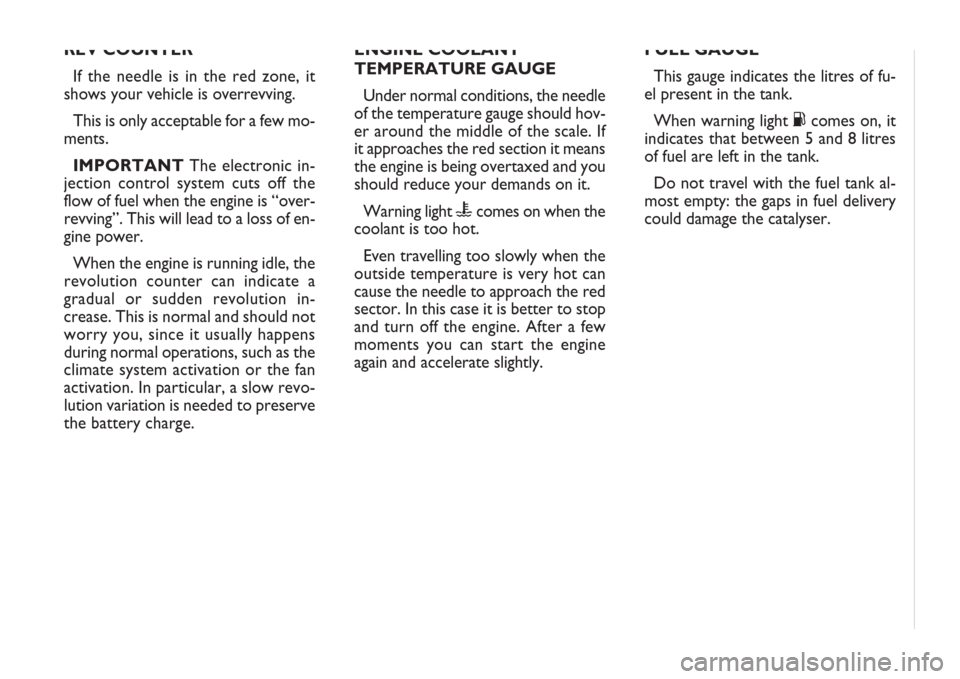
RIGHT-HAND DRIVE VERSIONS
239
ENGINE COOLANT
TEMPERATURE GAUGE
Under normal conditions, the needle
of the temperature gauge should hov-
er around the middle of the scale. If
it approaches the red section it means
the engine is being overtaxed and you
should reduce your demands on it.
Warning light
ucomes on when the
coolant is too hot.
Even travelling too slowly when the
outside temperature is very hot can
cause the needle to approach the red
sector. In this case it is better to stop
and turn off the engine. After a few
moments you can start the engine
again and accelerate slightly. REV COUNTER
If the needle is in the red zone, it
shows your vehicle is overrevving.
This is only acceptable for a few mo-
ments.
IMPORTANTThe electronic in-
jection control system cuts off the
flow of fuel when the engine is “over-
revving”. This will lead to a loss of en-
gine power.
When the engine is running idle, the
revolution counter can indicate a
gradual or sudden revolution in-
crease. This is normal and should not
worry you, since it usually happens
during normal operations, such as the
climate system activation or the fan
activation. In particular, a slow revo-
lution variation is needed to preserve
the battery charge.FUEL GAUGE
This gauge indicates the litres of fu-
el present in the tank.
When warning light Kcomes on, it
indicates that between 5 and 8 litres
of fuel are left in the tank.
Do not travel with the fuel tank al-
most empty: the gaps in fuel delivery
could damage the catalyser.